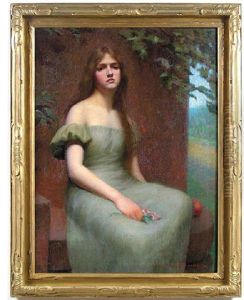Charles Atherton Cumming Paintings
Charles Atherton Cumming, born in 1853, was an American painter and educator who made significant contributions to the art community, particularly in the state of Iowa. Cumming is often remembered for his role in establishing and nurturing art education in the region, as well as for his own artistic work.
Cumming's early life was spent in the state of New York, where he was raised and received his initial education. He showed an early interest in art and soon pursued this passion by studying at the National Academy of Design in New York City. His dedication to his craft led him to further his studies abroad, a common practice among American artists of the time who sought to refine their techniques and absorb European artistic traditions. He studied at the Royal Academy in Munich, Germany, which was a popular destination for American art students in the late 19th century.
After completing his studies and spending some time in Europe, Cumming returned to the United States and moved to the Midwest. In 1880, he settled in Des Moines, Iowa, where he became a central figure in the state's art scene. His influence was most profoundly felt in his role as an educator. In 1901, he helped to found the Cumming School of Art, which later became part of the Des Moines Art Center. As an instructor and director of this institution, he was responsible for training a generation of artists and elevating the standards of art education in Iowa.
Cumming's own artistic work was primarily focused on portraiture and landscape painting. His portraits often depicted prominent citizens and leaders, while his landscapes captured the beauty of the Iowa countryside. Cumming's style was rooted in the academic tradition, reflecting the techniques and values he had absorbed during his European education. His work was exhibited at various venues, including the Iowa State Fairs and the Pennsylvania Academy of the Fine Arts.
Throughout his career, Cumming was a staunch advocate for the arts, believing in their importance for both the individual and the community. He was instrumental in establishing the Des Moines Association of Fine Arts, which became the governing body of the Des Moines Art Center, a key cultural institution in the region.
Charles Atherton Cumming passed away in 1932, leaving behind a legacy as a foundational figure in the development of the arts in Iowa. His dedication to art education and his efforts to cultivate an appreciation for the visual arts in the Midwest have had a lasting impact, and he is remembered as a pioneer in the cultural history of the state.


